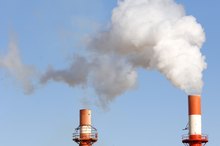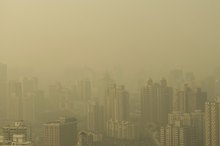Disadvantages of the Greenhouse Effect
As sunlight reaches the Earth, some of it reflects off the surface back towards space as infrared radiation, or heat. Greenhouse gases--carbon dioxide, methane, nitrous oxide and ozone--absorb this infrared radiation and trap heat in the atmosphere. However, large concentrations of greenhouse gases in the atmosphere lead to a phenomenon called the greenhouse effect, which results in climate change, a condition characterized by rising temperatures, rising sea levels and changing weather patterns 23. These environmental results of the greenhouse effect can have a detrimental effect in many areas of your life.
Health
Rising temperatures have a direct impact on human health. When exposed to high levels of heat, people can suffer from elevated body temperature, heat exhaustion, heat cramps and heat stroke. Trees, grasses, weeds and molds that cause:
- allergic reactions in people thrive in a warmer climate
- according to the Environmental Protection Agency
- or EPA [3](https://www.epa.gov/sites/production/files/signpost/cc.html 'inline-reference::EPA: Climate Change
- Ecosystems')
In addition, the EPA reports that diseases such as salmonella and cholera, which are transmitted through contaminated food and water, may become more widespread due to flooding. Increased activity among ticks and mosquitoes due to changing temperatures and rain patterns may transmit other illnesses, such as the West Nile virus, malaria and Lyme disease, across a wider area.
- Rising temperatures have a direct impact on human health.
- Trees, grasses, weeds and molds that cause: * allergic reactions in people thrive in a warmer climate
* according to the Environmental Protection Agency
* or EPA 3 In addition, the EPA reports that diseases such as salmonella and cholera, which are transmitted through contaminated food and water, may become more widespread due to flooding.
Water Resources
The Advantages of Rainfall
Learn More
The EPA states that changing weather patterns and higher temperatures affect the amount and quality of water resources available for human consumption. Droughts can dry up scarce water resources, a dangerous condition in desert-like regions, such as the Southwestern United States, that have limited water resources. On the other hand, severe storms and flooding can wash chemicals and other contaminants into rivers, streams and lakes, which lowers the quality of the water.
- The EPA states that changing weather patterns and higher temperatures affect the amount and quality of water resources available for human consumption.
- On the other hand, severe storms and flooding can wash chemicals and other contaminants into rivers, streams and lakes, which lowers the quality of the water.
Agriculture
Higher temperatures have negative effects on crops and livestock. Increasing temperatures in warmer areas of the globe might result in temperatures that are too high for certain crops to grow, according to the EPA. Changing rainfall patterns and more severe storms can also decrease crop yield. These conditions also place stress on livestock, causing animals, such as cattle, to sicken or die. As farmers and ranchers lose crops and livestock, food production will decrease, which can result in famines in some areas of the world.
- Higher temperatures have negative effects on crops and livestock.
- These conditions also place stress on livestock, causing animals, such as cattle, to sicken or die.
Energy Production
How Do Factories Pollute the Air?
Learn More
Rising temperatures require more energy for air conditioning during the summer. According to the EPA, increased use of air conditioning puts a strain on the power plants, transmission grids and distribution systems of power companies as they try to produce enough energy to meet the rising demands. This stress to the energy infrastructure could lead to brownouts or power outages during heat waves. Furthermore, consumers will likely see a rise in their electricity costs during these periods.
- Rising temperatures require more energy for air conditioning during the summer.
- Furthermore, consumers will likely see a rise in their electricity costs during these periods.
Ecosystems
The EPA defines an ecosystem as an interdependent system of plants, animals and microorganisms that interact with their physical environment and with each other. The greenhouse effect can significantly alter fragile land and water ecosystems and disrupt life in these regions. As the climate changes in certain regions, some plants and animals may be unable to adapt to these rapid changes and will either die or migrate to more hospitable regions. Thus, some ecosystems could lose entire species.
- The EPA defines an ecosystem as an interdependent system of plants, animals and microorganisms that interact with their physical environment and with each other.
- The greenhouse effect can significantly alter fragile land and water ecosystems and disrupt life in these regions.
Related Articles
References
Resources
Writer Bio
Marci Sothern has written as a tutor in the academic field since 1999. She holds a bachelor's degree in history and a master's degree in political science from the University of Texas at Tyler. Her main areas of expertise include American history, comparative politics, international relations and political theory.









